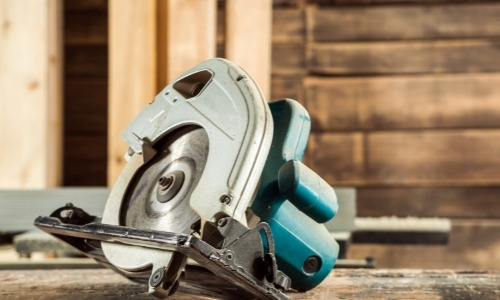If you are someone who does craftsmanship, then you probably often use power tools in your projects. Some common power tools that artisans use include drills, saws, grinders, and air compressors. These power tools make complicated and time-consuming tasks much more convenient to do.
Whether you are crafting something for personal or professional purposes, you are going to do a lot of cutting. For cutting, many power saws exist, like chainsaws, circular saws, table saws, and jigsaws. In this article, we will be looking at the workings of jigsaws and circular saws along with their strengths and weaknesses, as well as their popular models. Now, although these two saws are entirely different from each other, we are focusing on the two because they are often the first power tool a craftsman purchases.
Contents
- The Jigsaw
- The characteristics of a Jigsaw
- Applications Jigsaw is most suitable for
- Strengths of a Jigsaw
- Weaknesses of a Jigsaw
- Popular Jigsaw Models:
- 1. BOSCH 06033A0070 PST 700 E Compact Jigsaw
- 2. NETTA Electric Jigsaw 710W
- 3. DEWALT DCS334N-XJ Jigsaw
- The Circular Saw
- The characteristics of a Circular Saw
- Applications Circular Saw is most suitable for
- Strengths of a Circular Saw
- Weaknesses of a Circular Saw
- Popular Circular Saw Models
- 1. Makita DHS680Z Circular Saw
- 2. Evolution R185CCS Circular Saw
- 3. DeWalt DCS391N-XJ XR Circular Saw
- Comparison Chart
- Conclusion
The Jigsaw
We will start with the jigsaw first. The jigsaw was made by Albert Kaufmann, an Austrian engineer, in the year 1946. The saw came into existence when Albert decided to replace the needle of his wife’s sewing machine with a blade. In today’s day and age, the jigsaw comes in many different versions with more features added to the original, making it even more versatile.
Related: 10 Best jigsaws in 2022
The jigsaw has a singular toothed blade that moves back and forth against a material, hence cutting it. The jigsaw is capable of making many varieties of cuts, such as circular cuts, plunge cuts, and straight cuts. The jigsaw can cut through many materials, including wood, plastic, metal, and ceramic tiles.
The characteristics of a Jigsaw
A jigsaw has many key characteristics that define it. The first and essential characteristic is the blade itself, as it is used to make cuts on the material. The jigsaw has multiple interchangeable jigsaw blades, with each made for a specific material or for a specific situation.
The second feature is the stroke length. The stroke length refers to the distance the blade travels as it moves forward and backward during the cutting process. The higher the stroke length of a jigsaw, the faster it will cut through a material.
The third and final attribute is the motor. The motor is powered either by the energy provided by an electrical outlet or through a battery if you have a cordless jigsaw. The motor allows the blade to spin at high enough RPMs (rotations per minute) to be able to cut through materials.
Modern-day jigsaws have extra features added to them to make them even handier to use. Some examples are LED lights to make it easier to cut in low lighting areas and laser guiders, which allow for more precision cutting.
Applications Jigsaw is most suitable for
Jigsaws are mostly used in situations where precision is absolutely necessary. Jigsaws excel in curved cuts, plunge cuts, bevel cuts, and straight cuts. Projects that use stencilledFast-forwarding designs like carving wooden figures or homemade jigsaw puzzles allow you to make the best use out of your jigsaw.
Strengths of a Jigsaw
The most powerful strength of the jigsaw is the complicated cuts that it can make easily. Many crafting projects require very intricate cutting, such as crafting a butterfly or carving out letters and numbers. The jigsaw allows you to make these complex cuts conveniently. The jigsaw is also very compact, making it not only portable but also easier to control, especially in tight areas. Because of these properties, a jigsaw has no learning curve making it an excellent choice for beginners. The jigsaw is also a budget-friendly power tool being rather cheaper as compared to other power saws.
Weaknesses of a Jigsaw
Although the jigsaw has many strengths, no tool comes without some negatives. As compared to other power saws, while the jigsaw excels in intricate cutting, it lacks in power and blades. Due to it being compact, it does not offer a lot of power, making it inefficient in larger jobs. The blades of the jigsaw are also thinner as compared to other saws, making them more vulnerable to breaking. Fortunately, if the blades do break, jigsaws can be easily replaced due to them being inexpensive.
Popular Jigsaw Models:
1. BOSCH 06033A0070 PST 700 E Compact Jigsaw
Overall the best jigsaw, this model is not just very stable but also provides high accuracy and bevel capabilities. It also features a tool-less blade release, enabling you to change blades with ease.
2. NETTA Electric Jigsaw 710W
The NETTA NT-710W is by far the best affordable jigsaw. It has four orbital settings and a built-in dust blower to take care of any mess when the job is done.
3. DEWALT DCS334N-XJ Jigsaw
This model is one of the best jigsaws in the cordless category. The DEWALT DCS331B comes with a three-year warranty and provides clean and smooth cuts. The only problem is that since it is cordless, it is heavier as compared to other jigsaws due to its built-in battery.
The Circular Saw
The first circular saw was invented in 1922 by an American named Raymond Dewalt. His invention allowed for greater control of the cutting depth of materials. The first handheld circular saw, however, was invented later on, in 1929 by Art Emmons, also an American. Fast forwarding to the present, a circular saw today is most commonly used by people working in Lumber.
Related: Top 10 circular saws in uk
A circular saw has immense power, being able to cut through materials very quickly without compromising too much on accuracy as well. It comprises a circular, toothed cutting disc that can cut through wood, metal, and even stone. Circular saws, similar to jigsaws, come in two variants, corded and cordless.
The characteristics of a Circular Saw
The Circular Saw’s characteristics include the motor, the circular blade, and the most important, the bevel adjustment. The motor of a circular saw is similar to that of a jigsaw. The only difference is that the motor of a circular saw is capable of providing more power as compared to the motor of a jigsaw.
The circular, toothed disc blade of a circular saw can cut through materials at a swift pace. The blades of a circular saw are also more well built as compared to jigsaw blades. This is because the circular blades come under tremendous amounts of pressure while cutting due to the heat and the power.
Lastly, the bevel adjustment is what separates the circular saw from other power saws. The bevel adjustment controls the degree when making bevel cuts, which is a must-have feature when making angled cuts.
Applications Circular Saw is most suitable for
Circular saws are most suitable for cutting large wooden boards. These circular saws can be used for small cutting jobs and also large construction projects. Circular saws are able to cut through most materials with ease like masonry, metal, and sheet work.
Strengths of a Circular Saw
As you may have already determined, the greatest strength of a circular saw is its immense power, being able to cut through many materials at a quick pace. Circular saws are not only great at angled cuts but also in straight line cuts. They can also be accurate if the cutting is done at high speed.
Weaknesses of a Circular Saw
The weakness of a circular saw lies in its inability to make curved cuts. A circular saw is also very dangerous to use, requiring a slightly higher learning curve. Due to the power these circular saws possess, they can be hard to manage. The blades of a circular saw are also more expensive to replace as compared to that of a jigsaw, although the circular saw blades are sturdier and, therefore, will break less often.
See Also: How to use a circular saw
Popular Circular Saw Models
1. Makita DHS680Z Circular Saw
The Makita DHS680Z is a powerful circular saw capable of achieving up to 5000 RPMs. The model is equipped with an electric brake and ball bearing lower guard allowing for smooth retraction, keeping your saw in good condition no matter the working conditions.
2. Evolution R185CCS Circular Saw
This model provides high-quality specifications at a good price point. Capable of a top speed of 3900 RPMs, the Evolution R185CCS is a budget-friendly option with a built-in dust blower and a guarded trigger to prevent accidental start-ups.
3. DeWalt DCS391N-XJ XR Circular Saw
The DeWalt DCS391N-XJ XR circular saw is capable of achieving only 3700 RPMs. Still, its motor provides just enough power to finish the job. The fold-out metal handle makes operating the saw safe to handle.
Comparison Chart
| Circular Saw | Jigsaw | |
|---|---|---|
| Use | Mostly used for straight and long cuts, particularly in materials like plywood or medium-density fibreboard (MDF). Ideal for rip-cuts and cross-cuts. | Mostly used for curved and intricate cuts. Good for stencil design cutting and shaping. |
| Blade type | Uses a round blade with sharp teeth around the edge. Often larger than a jigsaw blade. | Uses a smaller, straight blade that moves up and down. |
| Cut type | Typically used for making clean, straight cuts. Can be used to cut angles but with less precision. | Can make more intricate cuts including curves and angles. |
| Material | Can cut through dense and thick materials, including metal and masonry, with the appropriate blade. | Best used on thinner materials, but can cut through metal and plastic with the right blade. |
| Safety | Generally requires more caution due to the power and potential kickback. | Generally safer to use due to its smaller, more controlled blade. |
| Portability | More robust and heavy, not as easy to maneuver as a jigsaw. | Lighter and more portable, allowing for easier maneuvering. |
| Versatility | Less versatile, primarily designed for straight cuts. | More versatile due to its ability to make various intricate cuts. |
Conclusion
The jigsaw and the circular saw both offer tremendous value to those in the craftsmanship industry, with each saw being more suitable than the other for a specific situation. If you are doing a large amount of cutting and only require straight-line cuts, then the circular saw is the best option for you. For tasks where precision is absolutely essential, that is where the jigsaw will shine. Whatever the task at hand, one thing is for sure that for a craftsman, both are must-have tools.


